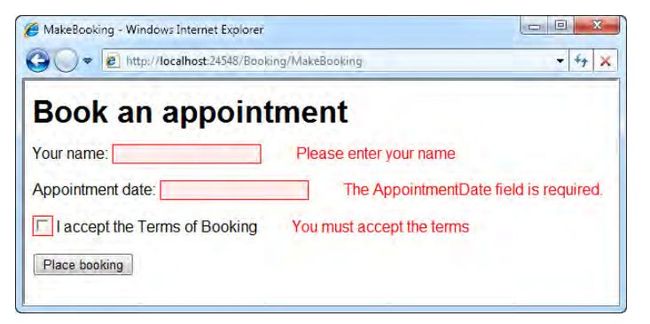MVC 验证和异常处理 开篇及简单示例
MVC 验证和异常处理 开篇及简单示例。
背景: MVC 验证和异常处理参考Pro ASP.NET MVC2 Framerowk Seciond Edition.Pdf,将会有书中示例出现在随笔中,或者由于个人能力问题,和原文有偏差。纯属个人加强记忆的随笔。欢迎指正。
开始第一篇 注册和 显示不合法验证信息
MVC 用ModelState 存储Model在请求间发生的一系列信息,包括后台数据合法性验证 。让我们用一个例子来说明使用方法:
后台定义个model和一个control
public class Appointment
{
public string ClientName { get; set; }
[DataType(DataType.Date)]
public DateTime AppointmentDate { get; set; }
}
public ActionResult MakeBooking(Appointment appt, bool acceptsTerms) {
if (string.IsNullOrEmpty(appt.ClientName))
ModelState.AddModelError("ClientName", "Please enter your name");
if (ModelState.IsValidField("AppointmentDate"))
{
// Parsed the DateTime value. But is it acceptable under our app's rules?
if (appt.AppointmentDate < DateTime.Now.Date)
ModelState.AddModelError("AppointmentDate", "The date has passed");
else if ((appt.AppointmentDate - DateTime.Now).TotalDays > 7)
ModelState.AddModelError("AppointmentDate",
"You can't book more than a week in advance");
}
if (!acceptsTerms)
ModelState.AddModelError("acceptsTerms", "You must accept the terms");
if (ModelState.IsValid)
{
// To do: Actually save the appointment to the database or whatever
return View("Completed", appt);
}
else
return View(); // Re-renders the same view so the user can fix the errors
}
重点在ModelState.AddModelError方法,主意它的参数,一个key,一条错误提示,key和view也就是aspx中的绑定的model属性名称一致。
下面看view怎么显示异常信息
最简单的方法是使用Html.ValidationSummary(),统一在某个地方显示所有异常信息。
<h1>Book an appointment</h1>
<%: Html.ValidationSummary() %>
结果大致如图所示
或者手工指定:
<% using(Html.BeginForm()) { %>
<p>
Your name: <%: Html.EditorFor(x => x.ClientName) %>
<%: Html.ValidationMessageFor(x => x.ClientName) %>
</p>
<p>
Appointment date:
<%: Html.EditorFor(x => x.AppointmentDate)%>
<%: Html.ValidationMessageFor(x => x.AppointmentDate) %>
</p>
<p>
<%: Html.CheckBox("acceptsTerms") %>
<label for="acceptsTerms">I accept the Terms of Booking</label>
<%: Html.ValidationMessage("acceptsTerms") %>
</p>
<input type="submit" value="Place booking" />
<% } %>
结果

